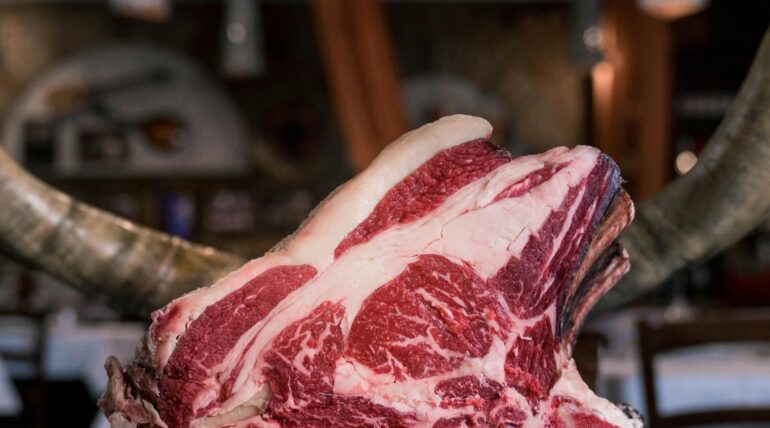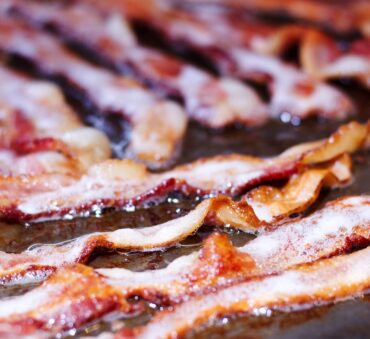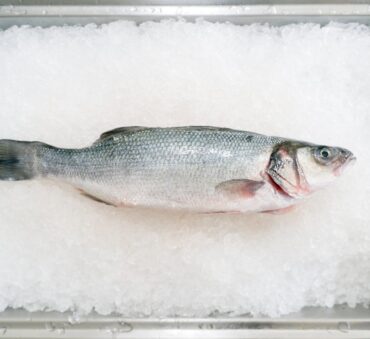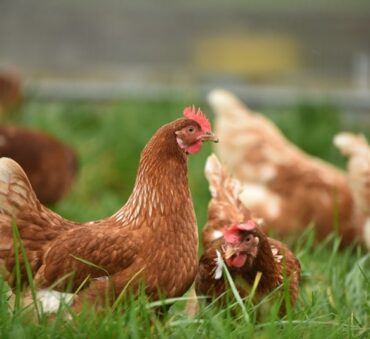The meat industry, with its high volume of butchery waste, faces a pivotal moment where sustainable management of this waste isn’t just an environmental imperative but a significant business strategy. Butchers, confronted with the dual challenges of rising disposal costs and strict environmental regulations, are now acknowledging that efficient disposal of meat waste transcends mere compliance. It’s a competitive advantage. This evolution towards sustainable waste practices signifies a deeper change in the industry’s approach to its byproducts. Moving away from conventional disposal methods to more innovative, eco-friendly solutions isn’t just about adhering to norms—it’s about transforming waste management into an opportunity for operational efficiency and bolstering brand reputation.
Key Takeaways
- Proper wine disposal, especially in larger quantities, is crucial to prevent environmental harm and legal consequences. Avoid pouring it down the drain or dumping it into the environment.
- Understanding the indicators of unusable wine, such as shelf life, quality deterioration, production errors, and faulty products, helps in responsible disposal.
- Consider sustainable options like vinegar production, industrial alcohol distillation, composting for agriculture, or working with specialized wine destruction services to reduce waste and environmental impact.
- Always adhere to state and federal disposal regulations when disposing of wine and avoid unverified or non-certified destruction services.
Types of Butchery Waste
Butcher shop waste extends beyond just dealing with leftover meat. The variety and volume of waste produced in these environments are multifaceted, each requiring its own approach for sustainable handling.
Meat Waste: This includes unused cuts of meat, fat, bones, and organs. Often, this type of waste presents the biggest challenge due to its biological nature, requiring careful handling to prevent contamination and adhere to health regulations.
General Waste: Day-to-day operations in butcheries generate general waste, such as paper towels, cleaning materials, and food packaging. This waste, while not as specialized as others, still requires efficient disposal methods.
Recyclables: Butcheries produce a significant amount of recyclable waste, including plastic, glass, and metal, mostly from packaging materials. Effective separation and recycling of these materials can significantly reduce their environmental impact.
Packaging Waste: Packaging materials like plastic wrap, cardboard boxes, and foam trays are ubiquitous in butcheries. These materials, while necessary for preserving and transporting meat, contribute substantially to waste volumes.
Clinical and Anatomical Waste: This type of waste includes any biological matter that is not intended for consumption, such as diseased tissues or organs. Its disposal is heavily regulated due to potential health risks.
Waste from Butchers’ Equipment: Sharpening debris from knives, worn-out cutting boards, and other equipment-related waste also needs proper management. This type of waste might not be as voluminous, but it’s essential to handle it correctly to maintain a safe and efficient work environment.
Environmental Consequences of Improper Meat Waste Disposal
The improper handling of butchery waste carries significant environmental risks that extend far beyond the confines of the butchery itself.
Soil Contamination: Beyond the immediate degradation of soil quality, contaminated soil can disrupt underground microbial communities essential for soil fertility and carbon cycling. This can lead to reduced agricultural productivity in nearby areas.
Greenhouse Gas Emissions: Methane emissions from butchery waste contribute to climate change, which can exacerbate extreme weather conditions, affecting not just local but global agriculture and food security.
Water Pollution: Pollution of water sources extends beyond immediate ecological damage. It can lead to the bioaccumulation of toxins in the food chain, impacting wildlife and human health on a much larger scale.
Disease Outbreaks: The risk of bacterial and viral outbreaks, such as those caused by Listeria, E. coli, and Salmonella, is also heightened. These outbreaks are not only a public health hazard but can also lead to significant economic repercussions for the butchery industry.
Biodiversity Loss: The cumulative effect of these environmental impacts can lead to a decrease in biodiversity. Contaminated environments and disrupted ecosystems can result in the loss of various plant and animal species, further destabilizing natural habitats.
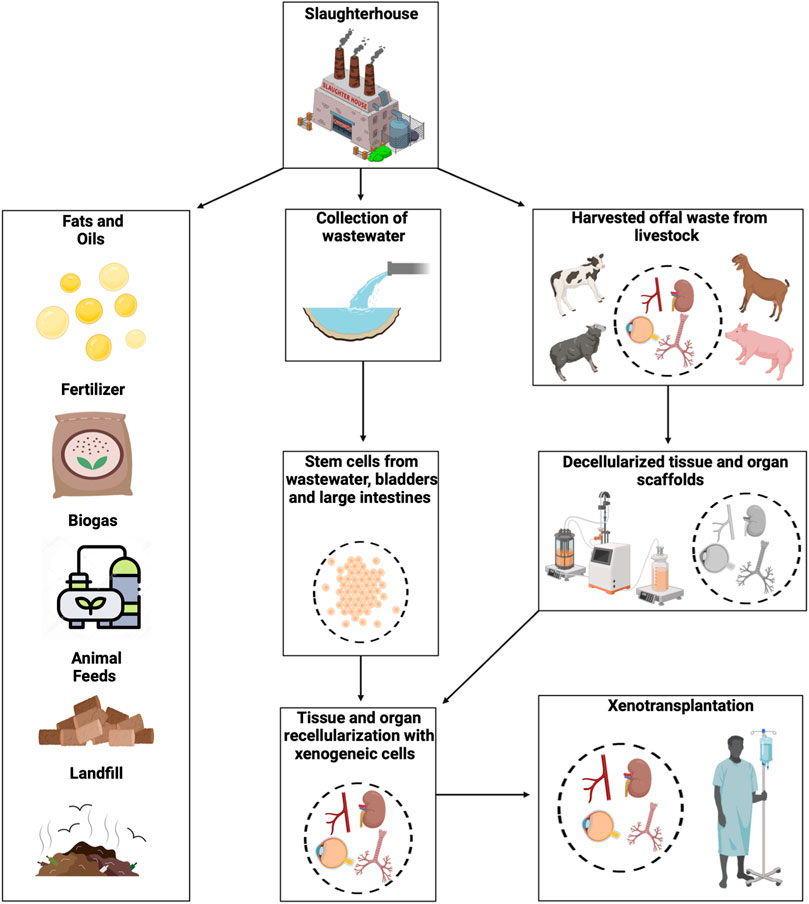
Legal Regulations of Meat Waste Disposal in the US
Effective waste management in the meat industry hinges on understanding and adhering to a series of stringent regulations that aim to safeguard the environment and public health from various angles.
Federal Meat Inspection Act (FMIA): This act mandates the sanitary processing of meat, including proper waste management. Its oversight by the USDA’s Food Safety and Inspection Service ensures that waste from meat processing meets health and safety standards.
Resource Conservation and Recovery Act (RCRA): The RCRA, governed by the Environmental Protection Agency, addresses the disposal of solid and hazardous wastes. Some meat waste falls under this act, requiring careful attention to disposal methods.
Clean Water Act (CWA): This act, crucial for meat processing facilities, is enforced by the EPA to regulate the discharge of pollutants, including runoff and wastewater, into U.S. waters.
EPA Guidelines: Beyond specific acts, the EPA provides extensive guidelines for environmentally sound waste management practices, applicable to meat waste.
State-Specific Regulations: Compliance with state regulations, which may exceed federal standards, is essential for meat processors, ensuring a comprehensive approach to waste management.
Causes of Meat Waste
Understanding the common causes of meat waste is vital for developing effective waste management strategies. Here are some key factors contributing to meat waste:
Overproduction: This often results from inaccurate demand forecasting or a strategy to prepare for potential demand spikes, leading to surplus meat that remains unsold and eventually wasted.
Product Spoilage: Meat’s perishability makes it susceptible to spoilage due to improper storage, temperature inconsistencies, or extended shelf life, rendering it unfit for consumption.
Processing Losses: Significant waste can occur during butchering and processing, as the trimming, cutting, and deboning stages inherently produce waste materials.
Packaging Failures: When packaging is compromised, meat gets exposed to air and contaminants, accelerating spoilage and leading to waste.
Consumer Preferences: The demand for specific cuts of meat can result in the underutilization or discarding of other parts, contributing to overall waste.
Portion Sizes: Misjudging portion sizes can create waste at both the production and food service levels, with excess meat being prepared but not consumed.
Supply Chain Inefficiencies: Disruptions or inefficiencies within the supply chain can lead to delays in delivery, risking spoilage before the meat reaches the market.
Retail and Restaurant Overstocking: Retailers and restaurants might overstock to maintain an appearance of abundance, which can result in waste if the surplus meat is not sold.
Cosmetic Standards: Meat that fails to meet aesthetic standards for size, shape, or color might be discarded, even if it’s otherwise perfectly edible.
Human Error: Mistakes in handling, preparing, or processing meat at any stage can lead to its wastage, either due to spoilage or safety concerns.
Meat Waste Reduction Strategies
Reducing waste at its source and finding innovative ways to repurpose it are key strategies for sustainable meat waste management. Here are some effective approaches:
- Optimizing Cutting Patterns: By refining cutting techniques and patterns, butchers and meat processors can maximize the yield from each animal, reducing the amount of waste generated during processing.
- Tight Inventory Management: Maintaining a lean inventory and using predictive analytics for demand forecasting can significantly reduce overproduction, thus minimizing waste.
- Repurposing Waste Materials: Many by-products of meat processing can be repurposed:
- Animal Fats: These can be transformed into products like soap or biodiesel.
- Bones: They can be used to create broth or gelatin, or even ground into meal for animal feed.
- Offal (Organs): Properly processed, these can be used in pet food or even as delicacies in certain cuisines.
- Collaboration with Other Industries:
- Agriculture: Meat waste can be composted and used as a nutrient-rich fertilizer in agriculture.
- Energy Sector: Waste can be converted into biogas, a renewable energy source, through anaerobic digestion.
- Fashion and Textiles: Hide and leather can be used in the fashion industry.
- Community Engagement and Food Donation: Unsellable but safe-to-eat meat can be donated to community programs, reducing waste while supporting local needs.
- Employee Training and Awareness: Educating staff about sustainable practices can lead to more efficient handling and processing, reducing waste.
- Advanced Preservation Techniques: Implementing state-of-the-art preservation methods can extend the shelf life of meat products, reducing spoilage.
- Packaging Innovations: Investing in improved packaging technologies can enhance shelf life and reduce spoilage, such as vacuum packing or modified atmosphere packaging.
The Numbers Related to Meat Waste in the United States
The issue of animal product waste in the U.S. presents a significant challenge on multiple levels.
Extent of Food Waste: Roughly one-third of food in the U.S. is wasted, contributing to environmental issues and missed opportunities for addressing food insecurity.
Environmental Impact: The EPA reports that food waste, which includes a substantial portion of animal products, is responsible for 2% of U.S. greenhouse gas emissions.
Animal Products and Waste: Meat, dairy, and eggs, though just over a quarter of the food waste by weight, have a larger environmental footprint due to higher resource use and emissions.
Animal Welfare: Reducing waste in animal products could prevent millions of animals from being raised on factory farms. Currently, a significant percentage of meat, poultry, and fish is discarded, indicating a large-scale inefficiency.
Consumer Influence: With about half of food waste occurring at the consumer level, practices such as better understanding food expiration, effective use of freezers, and mindful shopping can make a significant difference.
Farming and Processing Improvements: Modifying farming practices, especially in poultry, and enhancing processing efficiency can reduce waste, potentially lessening the number of animals needed for production.
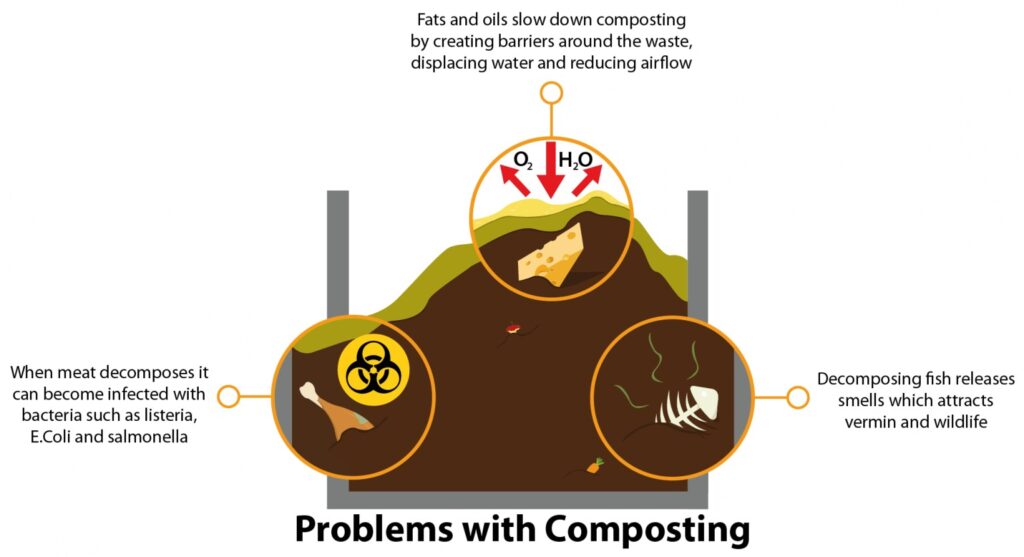
Butchery Waste Management: Meat Waste Disposal Guide
Traditional Disposal Methods and Their Drawbacks:
Landfilling: It leads to the production of methane, a significant contributor to climate change, and poses risks of groundwater contamination. Economically, the rising costs and potential regulatory fines make it less viable.
Incineration: While reducing waste volume, it releases pollutants into the atmosphere and fails to recover any reusable resources.
Shifting focus to sustainable alternatives offers a way forward.
Sustainable Disposal Options:
- Composting: Modern composting technologies transform meat waste into valuable soil amendments, doing so more efficiently and with less odor than traditional methods.
- Anaerobic Digestion: This process not only breaks down organic waste without oxygen but also produces biogas, a renewable energy source, and digestate for fertilization.
- Conversion into Animal Feed: Properly processed meat waste can be repurposed into animal feed, presenting a sustainable loop in resource usage.
Sustainable Disposal Options Through Professional Butcher Waste Collection and Disposal
Partnering with an organic recycling and disposal expert like Shapiro opens doors to these innovative approaches. Our expertise in food and agricultural waste solutions equips businesses with advanced technologies and knowledge for efficient waste handling. This collaboration can lead to:
- Enhanced Environmental Commitment: Adopting sustainable waste disposal aligns businesses with environmental goals and regulatory compliance.
- Economic Advantages: Efficient waste management can reduce costs and potentially create new revenue streams from by-products like biogas.
- Access to Expertise: Shapiro’s guidance helps businesses navigate waste management complexities, ensuring informed decision-making for sustainable practices.
In conclusion, transitioning from traditional to innovative waste disposal methods is crucial for environmental and economic reasons. Through strategic partnerships and advanced technologies, businesses can turn waste management into an asset rather than a liability.
FAQs
Yes, meat waste can be composted, but it requires careful management to avoid attracting pests and producing odors. Industrial composting facilities are better equipped to handle meat waste than typical backyard composting setups.
Yes, meat can be included in food waste. Many municipal food waste collection and recycling programs, including Shapiro, accept meat alongside other organic waste. It’s important to check local guidelines, as methods of disposal and types of accepted waste can vary.
Yes, meat is considered organic waste because it is biodegradable and comes from living organisms. In the context of waste management, ‘organic’ refers to materials that can decompose naturally.
Rotting meat itself is not classified as hazardous waste, but it can become a health hazard if not handled properly due to the potential for bacteria growth and odor issues.
Globally, large quantities of meat go to waste each year, but specific figures vary by region and year. For instance, in the U.S., it’s estimated that around 26% of meat, poultry, and fish at the retail and consumer level is wasted, according to USDA data.
Rotten meat should be disposed of in a sealed bag and placed in your general waste bin if your local waste management system does not accept meat in organic waste bins. It’s crucial not to dispose of it in open areas due to health risks and to prevent attracting animals.
For large quantities of rotten meat, such as a freezer full, it’s advisable to contact a waste disposal service, especially one that specializes in organic waste management like Shapiro. They can ensure that the waste is handled and disposed of in an environmentally responsible manner, potentially turning it into useful byproducts through processes like anaerobic digestion.
Baily Ramsey, an accomplished marketing specialist, brings a unique blend of anthropological insight and marketing finesse to the digital landscape. Specializing in educational content creation, she creates content for various industries, with a particular interest in environmental initiatives.
